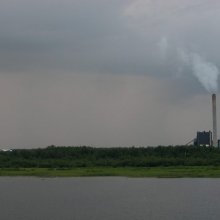Environmental Issues in the U.S. Today
 With a population exceeding 25 million people, pollution is a problem for Texas. (Photo: Images )
With a population exceeding 25 million people, pollution is a problem for Texas. (Photo: Images )
Related Articles
Texas' extraordinary size brings with it an equal scope of both opportunity and challenge: The state is particularly well supplied with raw materials for the production of petrochemical and chemical goods, but exploiting these natural resources creates environmental impacts. The Texas Legislature must therefore constantly strive to balance economic necessity with environmental threat. The imposition of environmental regulation necessarily curbs and restrains production, so lawmakers must at least appear not to favor one interest group over the other.
Air
Texas is the largest emitter of carbon in the United States. As well as problems shared with other states - these include emissions from construction sites, manufacturing industries, automobiles, buses, trucks and aircraft - the massive oil refineries of the Gulf coast and the burn-off from oil and gas fields are issues unique to Texas within the contiguous United States. All introduce ozone, carbon monoxide, nitrogen dioxide, particulate matter and lead into the air breathed by the very people whose personal finances would collapse without the industry. Airborne emissions leach from the atmosphere into water, soil, crops and livestock, thereby creating secondary issues.
Water
Water quality in Texas is confronted by many of the same issues that dog other more densely populated states, including run-off from centers of population, factories and farms that all alter the chemical constitution of water. Levels of mercury so high that fish and shellfish become inedible are the results most frequently noticed by the public, because the Texas Parks and Wildlife Department issues advisories to avoid consumption. Other, less high-profile risks include conspicuous mass kill-offs of fish and animals and an increase in algal blooms and invasive flora in valleys and floodplains. Cross-contamination from waste can introduce potentially lethal bacteria such as E. coli into water that is eventually consumed by humans.
Maquiladoras
A problem particular to the border states that abut Mexico are the maquiladoras - massive factories and assembly plants - that have been encouraged since the mid-1960s. These factories are truly Brobdingnagian in scale; tens of thousands of people are employed primarily by U.S. and Asian manufacturers to assemble goods for the North American market. The maquiladoras are located on the Mexican side of the border so close to U.S. territory that they can be seen; their byproduct pollutants are therefore introduced into U.S. air and the water of the Rio Grand River. Through the 1990s many Texas counties experienced pollution increases of more than a quarter, and some by almost 50 percent.
Financial Considerations
The Texas Commission on Environmental Quality - TCEQ - is tasked with providing Texas lawmakers with unbiased information that allows them to protect the health and well-being of citizens. Ironically, financial levies imposed upon companies that pollute the air and water are such that cleaning up problems is often more costly than simply paying a fine and moving on. This scenario - hardly unique to Texas, but a distinct consideration in the state - makes it cheaper to pollute than to not pollute: companies are literally paid to create environmental problems.




